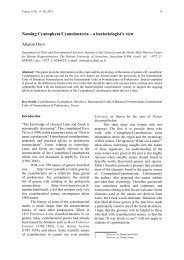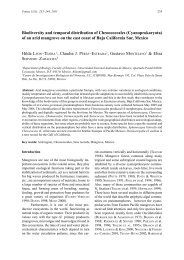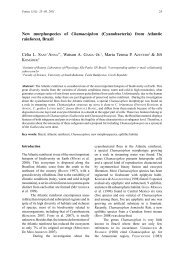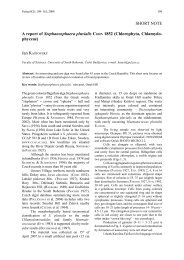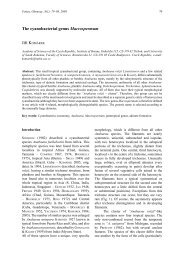The pyrenoid ultrastructure in Oocystis lacustris CHODAT ... - Fottea
The pyrenoid ultrastructure in Oocystis lacustris CHODAT ... - Fottea
The pyrenoid ultrastructure in Oocystis lacustris CHODAT ... - Fottea
Create successful ePaper yourself
Turn your PDF publications into a flip-book with our unique Google optimized e-Paper software.
<strong>Fottea</strong> 9(1): 149–154, 2009 149<br />
<strong>The</strong> <strong>pyrenoid</strong> <strong>ultrastructure</strong> <strong>in</strong> <strong>Oocystis</strong> <strong>lacustris</strong> Ch o d at (Chlorophyta,<br />
Trebouxiophyceae)<br />
Maya P. St o y n e va 1 , Elisabeth In g o l I ć 2 , Georg Gä rt n e r 3* & Wim vy v e r m a n 4<br />
1 Sofia University “St Kliment Ohridski”, Faculty of Biology, Department of Botany, 8 bld. Dragan Zankov, BG–<br />
1164 Sofia, Bulgaria<br />
2 Forschungs<strong>in</strong>stitut für Elektronenmikroskopie und Fe<strong>in</strong>strukturforschung, Steyrergasse 17, A–8010 Graz,<br />
Austria<br />
3* Leopold-Franzens-Universität Innsbruck, Institut für Botanik, Sternwartestr. 15, A–6020 Innsbruck, Austria;<br />
correspond<strong>in</strong>g author: e-mail: georg.gaertner@uibk.ac.at<br />
4 Ghent University, Department Biology, Laboratory of Protistology and Aquatic Ecology, Krijgslaan 281–S8,<br />
B–9000 Gent, Belgium<br />
Dedicated to Dr. Pe t r ma rva n on the occasion of his 80 th birthday<br />
Abstract: <strong>The</strong> f<strong>in</strong>e structure of vegetative cells of <strong>Oocystis</strong> <strong>lacustris</strong> has been studied with special attention to<br />
the <strong>ultrastructure</strong> of the <strong>pyrenoid</strong> and its starch sheath. <strong>The</strong> TEM-<strong>in</strong>vestigation showed that the <strong>pyrenoid</strong> matrix<br />
is homogenous, not traversed by thylakoids and the surround<strong>in</strong>g starch sheath is cont<strong>in</strong>uous, horseshoe-shaped or<br />
fragmented <strong>in</strong> 2 starch plates. This starch sheath structure is regarded as a common feature with<strong>in</strong> <strong>Oocystis</strong> and<br />
closely related genera Eremosphaera and Neglectella.<br />
Key words: <strong>Oocystis</strong> <strong>lacustris</strong>, <strong>ultrastructure</strong>, <strong>pyrenoid</strong>s, starch sheath<br />
Introduction<br />
Photosynthetic pigments, storage products and<br />
structure of plastids are some of the important<br />
features <strong>in</strong> the taxonomy of eukaryotic algae. In<br />
many types of algae with<strong>in</strong> the chloroplast occurs<br />
a dense prote<strong>in</strong>aceous body, visible with light<br />
microscope and designated as a <strong>pyrenoid</strong>. <strong>The</strong><br />
term “<strong>pyrenoid</strong>” was created by Sc h m i t z (1882)<br />
who was the first to associate this structure with an<br />
effect on the accumulation of starch gra<strong>in</strong>s <strong>in</strong> the<br />
chloroplasts of green algae. Nowadays it is well<br />
known that <strong>pyrenoid</strong>s conta<strong>in</strong> the carbon fix<strong>in</strong>g<br />
enzyme Rubisco and are commonly associated<br />
with formation of storage products (e.g. Gr a h a m<br />
& Wi l c o x 2000, le e 2008). A remarkable number<br />
of morphological types of <strong>pyrenoid</strong>s exists (e.g.<br />
Do D G e 1973, et t l 1980, Wh at l e y 1993). <strong>The</strong><br />
absence or presence of <strong>pyrenoid</strong>s <strong>in</strong> vegetative<br />
cells was already used as a taxonomic criterion<br />
on the generic level of algae (Sta r r 1955, hi n D a k<br />
1977-1990) whereas the morphology of the starch<br />
sheath itself, its structure, and location can assist<br />
<strong>in</strong> the identification of green algal species (Br o W n<br />
& mcle a n 1969, et t l 1976, ko m á r e k & Fo t t<br />
1983, et t l & Gä rt n e r 1988a). <strong>The</strong> starch sheath<br />
of green algal <strong>pyrenoid</strong>s is normally visible with<br />
light microscopе (et t l 1980) especially when<br />
sta<strong>in</strong>ed with reagents such as Lugol’s iod<strong>in</strong>e<br />
solution. <strong>The</strong> ma<strong>in</strong> structure of the <strong>pyrenoid</strong><br />
matrix (homogenous, perforated, lamellate or<br />
traversed by thylakoids) is also visible <strong>in</strong> LM with<br />
extraord<strong>in</strong>ary optical equipment and when sta<strong>in</strong>ed<br />
with reagents such as azocarm<strong>in</strong>e-G solution<br />
(et t l 1976, 1983, Gä rt n e r 1985). <strong>The</strong> electron<br />
microscopy only cleared characteristic <strong>in</strong>ternal<br />
details of the <strong>pyrenoid</strong> matrix (Gi B B S 1962, Do D G e<br />
1973, PI c k e t t-He a P s 1975, Fr I e d l 1989, In g o l I ć &<br />
Gä rt n e r 2003). Among the members of the genus<br />
<strong>Oocystis</strong> A. Br. the <strong>ultrastructure</strong> of a <strong>pyrenoid</strong><br />
with horseshoe-shaped starch sheath was first<br />
shown by Sc h n e P F, ko c h & De i c h G r ä B e r (1966,<br />
p. 165, fig. 33) <strong>in</strong> a schematic graph of <strong>Oocystis</strong><br />
solitaria Wi t t r o c k f. maior Wi l l e. Later on,<br />
ro B i n S o n & Wh i t e (1972, p. 112, fig. 5) presented<br />
a <strong>pyrenoid</strong> <strong>in</strong> one TEM-micrograph of <strong>Oocystis</strong><br />
apiculata W. We S t, and recently So l D o et al.<br />
(2005, p. 314, fig. 2 A) documented the <strong>pyrenoid</strong><br />
of <strong>Oocystis</strong> nephrocytioides Fo t t et Ča d o <strong>in</strong> a<br />
micrograph of an ultra th<strong>in</strong> cell section.<br />
In this paper the ultrastructural details of<br />
the <strong>pyrenoid</strong> <strong>in</strong> cells of <strong>Oocystis</strong> <strong>lacustris</strong> ch o D at<br />
are described for first time and comparison with<br />
the related genera Neglectella Vo d e n I Č a r o V
150 St o y n e va et al.: <strong>The</strong> <strong>pyrenoid</strong> <strong>ultrastructure</strong><br />
et Be n D e r l i e v, Eremosphaera De Ba ry and<br />
Siderocelis Fo t t is done.<br />
Material and methods<br />
<strong>Oocystis</strong> <strong>lacustris</strong> material was obta<strong>in</strong>ed from selected<br />
phytoplankton samples from Lake Tanganyika dated<br />
June–July 2003 when it formed dense populations<br />
(St o y n e va et al. 2007) and fixed <strong>in</strong> acid Lugol’s<br />
solution. For detailed description of localities, sampl<strong>in</strong>g<br />
and methods refer to St o y n e va et al. (2007). For TEM<br />
study cells were fixed a) <strong>in</strong> 3% glutaraldehyd <strong>in</strong> 0,1 M<br />
cacodylate buffer and b) <strong>in</strong> 1% aqueous O s O 4 <strong>in</strong> 0,1 M<br />
cacodylatbuffer, dehydrated <strong>in</strong> acetone and embedded<br />
<strong>in</strong> Spurr’s res<strong>in</strong>e¸ ultrath<strong>in</strong> sections were sta<strong>in</strong>ed with<br />
uranyl acetate and lead citrate (re y n o l D S 1963).<br />
Electron micrographs were taken with a Tecnai 12<br />
(FEI) microscope equipped with a Gatan ccd camera.<br />
Results<br />
In ultra th<strong>in</strong> sections most of the vegetative cells of<br />
<strong>Oocystis</strong> <strong>lacustris</strong> conta<strong>in</strong> one parietal chloroplast<br />
fill<strong>in</strong>g more than half of the cell size (Figs 1c,<br />
3c). However, sometimes also two chloroplasts,<br />
and, occasionally, four or more of them have been<br />
observed. <strong>The</strong>ir thylakoids occur <strong>in</strong> pairs. In each<br />
chloroplast one <strong>pyrenoid</strong> with a homogenous matrix<br />
is situated and surrounded by a thick starch sheath<br />
(Figs 1p, 2p, 3p). <strong>The</strong> diameter of the <strong>pyrenoid</strong><br />
body is between 1 and 1.5 µm; the thickness of<br />
the starch sheath is about 0.25 µm. Thylakoids<br />
are not travers<strong>in</strong>g the <strong>pyrenoid</strong> matrix. <strong>The</strong> starch<br />
sheath around the <strong>pyrenoid</strong> appears like a closed<br />
r<strong>in</strong>g (Fig. 2) or as a horseshoe-shaped starch plate<br />
(Fig. 3). <strong>The</strong>re can also be a sheath consist<strong>in</strong>g of<br />
two starch plates, more or less regular <strong>in</strong> thickness<br />
(Fig. 1 st). Additionally, s<strong>in</strong>gle lenticular starch<br />
gra<strong>in</strong>s, which are not <strong>in</strong> close association with<br />
the <strong>pyrenoid</strong>, are visible <strong>in</strong>side the chloroplast<br />
(Fig. 2s). <strong>The</strong>se stroma starch gra<strong>in</strong>s may reach<br />
Fig. 1 Vegetative cell of <strong>Oocystis</strong> <strong>lacustris</strong> with 1 chloroplast<br />
(c) and a starch sheath (st) consist<strong>in</strong>g of two starch plates<br />
around the homogenous matrix of the <strong>pyrenoid</strong> (p). n =<br />
nucleus. Scale bar 1 µm.<br />
Fig. 2 Pyrenoid (p) with homogenous starch sheath and<br />
additional stroma starch gra<strong>in</strong>s (s) <strong>in</strong> the chloroplast. n =<br />
nucleus. Scale bar 1µm.<br />
Fig. 3 Chloroplast (c) with <strong>pyrenoid</strong> (p) and homogenous<br />
horseshoe-shaped starch sheath. Scale bar 1µm.
<strong>Fottea</strong> 9(1): 149–154, 2009 151<br />
considerable dimensions (up to 0.25–0.75 µm). A<br />
s<strong>in</strong>gle nucleus is embedded <strong>in</strong> the cell lumen (Figs<br />
1n, 2n). <strong>The</strong> cell wall is multilayered (Figs 1–3).<br />
Its appearance <strong>in</strong> wavy structure, most probably,<br />
is a result of fixation and dehydration dur<strong>in</strong>g<br />
preparation.<br />
Discussion<br />
<strong>The</strong> f<strong>in</strong>d<strong>in</strong>g of the multilayered cell wall dur<strong>in</strong>g<br />
this study is <strong>in</strong> conformity with all previous data,<br />
which showed that the cell walls <strong>in</strong> Oocystaceae<br />
Bo h l i n are composed of several layers and this<br />
diacritic criterion is <strong>in</strong> accordance with the<br />
molecular data (ko m á r e k 1979, he P P e r l e et al.<br />
2000).<br />
<strong>The</strong> <strong>pyrenoid</strong>s and their starch components<br />
are of great value among the ma<strong>in</strong> diagnostic<br />
features for identify<strong>in</strong>g coccal green algae with<br />
light microscope. <strong>The</strong>ir structure can be cleared<br />
up by us<strong>in</strong>g sta<strong>in</strong><strong>in</strong>g procedures and squash<strong>in</strong>gmethod<br />
(et t l & Gä rt n e r 1988b, 1995). For<br />
further taxonomic <strong>in</strong>vestigations of unicellular<br />
green algae on species level TEM studies of<br />
ultrastructural details of cell components are<br />
important. Among them the <strong>pyrenoid</strong> matrix<br />
(homogenous, with <strong>in</strong>vag<strong>in</strong>ations or travers<strong>in</strong>g<br />
thylakoids) comb<strong>in</strong>ed with details of the starch<br />
sheath composition are significant. Br o W n & Bo l D<br />
(1964) and Br o W n & mcle a n (1969) were the<br />
first who used the <strong>ultrastructure</strong> of the <strong>pyrenoid</strong><br />
and number and position of starch gra<strong>in</strong>s to<br />
classify various species of the green algal genera<br />
Chlorococcum me n e G h i n i and Tetracystis Br o W n<br />
et Bo l D. In the genus Trebouxia Pu y m a ly tubular<br />
or ramified <strong>in</strong>vag<strong>in</strong>ations <strong>in</strong>to the <strong>pyrenoid</strong> matrix<br />
and thylakoids travers<strong>in</strong>g through the matrix were<br />
shown to be species-specific (Fr I e d l 1989, In g o l I ć<br />
& Gä rt n e r 2003).<br />
Profound light microscopical <strong>in</strong>vestigations<br />
of some genera of the Oocystaceae family have<br />
been published previously (e.g. Pl ay Fa i r 1916,<br />
Sk u j a 1956, Fo t t & ka l i n a 1962, Fo t t &<br />
Ře H á k o V á 1963, sm It H & Bo l d 1966, Ře H á k o V á<br />
1969, hi n D á k 1977–1990, ko m á r e k & Fo t t<br />
1983) and recently LM observations on <strong>Oocystis</strong><br />
<strong>lacustris</strong> from tropical Lake Tanganyika have been<br />
documented by St o y n e va et al. (2007). However,<br />
for a comprehensive cytomorphological and<br />
taxonomic study of the whole group (subfamilies<br />
Oocystoideae and Eremosphaeroideae <strong>in</strong> ko m a r e k<br />
& Fo t t 1983) still more <strong>in</strong>vestigations of cell<br />
<strong>ultrastructure</strong> and the <strong>pyrenoid</strong> construction would<br />
be necessary.<br />
<strong>The</strong> genus Siderocelis Fo t t was also<br />
placed <strong>in</strong>to the Oocystoideae (Fo t t 1976) based<br />
on detailed light microscopy (Fo t t 1976, hi n D á k<br />
1977-1990) but yet the f<strong>in</strong>e structure of its cells<br />
<strong>in</strong> most of the species is unknown. Identical<br />
cell wall structures of Amphikrikos nanus (Fot t<br />
et hey n i G) hi n D á k = Siderocelis nana Fo t t et<br />
he y n i G to <strong>Oocystis</strong> species were documented by<br />
cr aW F o r D & he a P (1978). Recent TEM-studies<br />
of Siderocelis irregularis hi n D á k from Lake<br />
Tanganyika revealed its <strong>pyrenoid</strong> organization:<br />
matrix traversed by s<strong>in</strong>gle undulat<strong>in</strong>g thylakoids<br />
and starch sheath consist<strong>in</strong>g of 2–10 plates<br />
(St o y n e va et al. 2008, p. 798, figs. 21, 22). This<br />
structure is clearly different from the <strong>pyrenoid</strong>s of<br />
<strong>Oocystis</strong> and Eremosphaera, as they are discussed<br />
below. This could be accepted as additional prove<br />
for the exclusion of Siderocelis from Oocystaceae<br />
(et t l & ko m á r e k 1982, ko m á r e k & Fo t t 1983).<br />
Nevertheless, the degree of relationship of<br />
Siderocelis to the Oocystaceae and its <strong>in</strong>clusion<br />
<strong>in</strong> the trebouxiophycean l<strong>in</strong>eage (tS a r e n k o et al.<br />
2006) need support of molecular <strong>in</strong>vestigations,<br />
which still are lack<strong>in</strong>g.<br />
In the genus Neglectella Vo d e n I Č a r o V<br />
et BenDer l i e v, generally regarded as close<br />
to <strong>Oocystis</strong>, a <strong>pyrenoid</strong> with massive, thick<br />
cont<strong>in</strong>uous and homogenous starch sheath is<br />
described (Be n D e r l i e v 1971, Vo d e n I Č a r o V &<br />
Be n D e r l i e v 1971). Accord<strong>in</strong>g to the comparative<br />
studies of Be n D e r l i e v (1971) and the text <strong>in</strong><br />
Vo d e n I Č a r o V & Ben d e r l I e V (1971) the <strong>pyrenoid</strong><br />
of Neglectella is of the same type as the <strong>pyrenoid</strong><br />
of Eremosphaera viridis De Ba ry. This co<strong>in</strong>cides<br />
extensively with the descriptions given by Fo t t<br />
& ka l i n a (1962) but is <strong>in</strong> opposition to Sm i t h<br />
& Bo l D (1966, p. 25) where <strong>in</strong> E. viridis “a<br />
number of polygonal starch gra<strong>in</strong>s often surround<br />
the <strong>pyrenoid</strong>s, especially <strong>in</strong> ag<strong>in</strong>g or nitrogendeficient<br />
cells”. Such discrepancies could be<br />
based on different cultivation conditions. Recently<br />
<strong>in</strong> the description of Eremosphaera tanganyikae<br />
St o y n e va, Gä rt n e r, co c q u y t et vyver m a n<br />
(St o y n e va et al. 2006) some diagnostic features<br />
of <strong>pyrenoid</strong> and starch sheath - visible with light<br />
microscope - were <strong>in</strong>cluded. <strong>The</strong> starch sheath was<br />
shown to conta<strong>in</strong> two plates (St o y n e va et al. 2006,<br />
figs. 37, 39). <strong>The</strong>se results generally co<strong>in</strong>cide with<br />
our LM observations on <strong>Oocystis</strong> <strong>lacustris</strong>, where<br />
cont<strong>in</strong>uous starch sheath was detected (St o y n e va<br />
et al. 2007, p. 587) and with our recent TEM
152 St o y n e va et al.: <strong>The</strong> <strong>pyrenoid</strong> <strong>ultrastructure</strong><br />
<strong>in</strong>vestigations, show<strong>in</strong>g that starch plates do not<br />
exceed two <strong>in</strong> number.<br />
<strong>The</strong> presence or absence of a <strong>pyrenoid</strong> is<br />
documented for most species of <strong>Oocystis</strong> (e.g.<br />
Sk u j a 1956, Bo u r r e l ly 1966, Ph i l i P o S e 1967,<br />
hi n D á k 1977–1990, ko m á r e k 1983, ko m á r e k<br />
& Fo t t 1983, jo h n & tS a r e n k o 2002), but<br />
the organization of the starch sheath was often<br />
neglected. A special note about the cont<strong>in</strong>uous<br />
starch sheath was provided by Fo t t & Ča d o (1966)<br />
<strong>in</strong> their LM diagnosis of <strong>Oocystis</strong> nephrocytioides.<br />
<strong>The</strong> TEM photo <strong>in</strong> So l D o et al. (2005) reveals<br />
a <strong>pyrenoid</strong> with homogenous matrix and bipartite<br />
starch sheath. Observations with TEM of <strong>Oocystis</strong><br />
apiculata showed a “bilenticular” <strong>pyrenoid</strong> type<br />
(ch a D e Fa u D 1941, ho r i & ue D a 1967) traversed<br />
by thylakoids and enclosed by a starch sheath<br />
fragmented <strong>in</strong> two parts (ro B i n S o n & Wh i t e<br />
1972).<br />
Our results on <strong>Oocystis</strong> <strong>lacustris</strong> co<strong>in</strong>cide<br />
partially with the observations on O. apiculata.<br />
In O. apiculata, as well as <strong>in</strong> O. <strong>lacustris</strong>, the<br />
starch envelope around the <strong>pyrenoid</strong> appears<br />
cont<strong>in</strong>uous or fragmented <strong>in</strong> two parts. But O.<br />
apiculata <strong>pyrenoid</strong>s are traversed by a simple<br />
(s<strong>in</strong>gle) tubular thylakoid system as it is shown by<br />
ro B i n S o n & Wh i t e (1972, p.112, fig. 5). This was<br />
never observed <strong>in</strong> cells of O. <strong>lacustris</strong> where the<br />
<strong>pyrenoid</strong> matrix appeared homogenous and was<br />
not traversed by thylakoids (Figs 1–3). <strong>The</strong>refore<br />
it is clear that the type of <strong>pyrenoid</strong> matrix<br />
(homogenous or traversed by thylakoids) still<br />
needs further studies and, most probably, is not a<br />
diacritic feature <strong>in</strong> <strong>Oocystis</strong> and <strong>in</strong> Oocystaceae.<br />
However, it seems that cont<strong>in</strong>uous or slightly<br />
fragmented starch sheath with at most two starch<br />
plates is a common diagnostic feature <strong>in</strong> members<br />
of the genus <strong>Oocystis</strong> and its closely related genera<br />
Neglectella and Eremosphaera, but this still has to<br />
be verified by further observations with TEM on<br />
more species.<br />
Acknowledgements<br />
<strong>The</strong> work was partially supported <strong>in</strong> the frame of a<br />
research fellowship for the first author (M. P. St.) by the<br />
Belgian Science Policy Office (CLIMLAKE project)<br />
and by a research fellowship for the third author (G.<br />
Gä.) f<strong>in</strong>anced by the Austrian Research Association<br />
(MOEL-project nr. 118).<br />
References<br />
Be n D e r l i e v, k. (1971): Bau und Entwicklung des<br />
Pyrenoids bei Eremosphaera viridis und<br />
Neglectella eremosphaerophila vo D. et Be n-<br />
D e r l. – Nova Hedwigia 21: 789–800.<br />
Bo u r r e l ly, P. (1966): Les algues d’eau douce. I. –<br />
511pp., Boubée & Cie., Paris.<br />
Br o W n , r. m., jr. & mcle a n, r. j. (1969): New taxonomic<br />
criteria <strong>in</strong> classifications of Chlorococcum<br />
species. II. Pyrenoid f<strong>in</strong>e structure. – J.<br />
Phycol. 4: 114–118.<br />
Br o W n , r. m. & Bo l D, h. c. (1964): Phycological<br />
Studies 5. Comparative studies of the algal<br />
genera Tetracystis and Chlorococcum. – Univ.<br />
Texas Publ. 6417: 1–213.<br />
ch a D e Fa u D, m. (1941): Les pyrénoïdes des algues et<br />
l’ existence chez ces végétaux d’un appareil<br />
c<strong>in</strong>étique <strong>in</strong>traplastidial. – Ann. Sci. Nat. Bot.<br />
11: 1–44.<br />
cr aW F o r D, r. m. & he a P, P. F. (1978) : Transmission<br />
electron microscopy X-ray microanalysis of<br />
two algae of the genera Scenedesmus and<br />
Siderocelis. – Protoplasma 96: 361–367.<br />
Do D G e, j. D. (1973): <strong>The</strong> F<strong>in</strong>e Structure of Algal Cells.<br />
– 261 pp., Academic Press, London, New York.<br />
et t l, h. (1976): Die Gattung Chlamydomonas<br />
eh r e n B e r G. – Beih. Nova Hedwigia 49:<br />
1–1122.<br />
et t l, h. (1980): Grundriß der allgeme<strong>in</strong>en Algologie.<br />
– 549 pp., VEB Gustav Fischer, Jena.<br />
et t l, h. (1983): Chlorophyta I. Phytomonad<strong>in</strong>a.<br />
– In: et t l, h., Ge r l o F F, j., he y n i G, h. &<br />
mo l l e n h a u e r, D. (eds): Süßwasserflora von<br />
Mitteleuropa 9. – 807 pp., Gustav Fischer,<br />
Stuttgart, New York.<br />
et t l, h. & Gä rt n e r, G. (1988a): Chlorophyta II.<br />
Tetrasporales, Chlorococcales, Gloeodendrales.<br />
– In: et t l, h., Ge r l o F F, j., he y n i G, h. &<br />
mo l l e n h a u e r, D. (eds): Süßwasserflora von<br />
Mitteleuropa 10. – 436 pp., Gustav Fischer,<br />
Stuttgart, New York.<br />
et t l, h. & Gä rt n e r, G. (1988b): E<strong>in</strong>e e<strong>in</strong>fache Methode<br />
zur Darstellung der Struktur der Stärkehüllen<br />
von Pyrenoiden bei Grünalgen (Chlorophyta).<br />
– Arch. Protistenk. 135: 179–181.<br />
et t l, h. & Gä rt n e r, G. (1995): Syllabus der Boden-,<br />
Luft- und Flechtenalgen. – 721 pp., Gustav<br />
Fischer, Stuttgart, Jena, New York.<br />
et t l, h. & ko m á r e k, j. (1982): Was versteht man<br />
unter dem Begriff “coccale Grünalgen”? –<br />
Arch. Hydrobiol. Suppl. 60, 4, Algol. Stud. 29:<br />
345–374.<br />
Fo t t, B. (1976): <strong>Oocystis</strong> und verwandte Gattungen<br />
aus der Unterfamilie der Oocystoideae;<br />
Namensänderungen, taxonomische Notizen und<br />
Bestimmungsschlüssel. – Preslia 48: 193–206.<br />
Fo t t, B. & Ča d o, I. (1966): <strong>Oocystis</strong> nephrocytioides
<strong>Fottea</strong> 9(1): 149–154, 2009 153<br />
sp. nov. – Phycologia 6: 47–50.<br />
Fo t t, B. & ka l i n a, t. (1962): Über die Gattung<br />
Eremosphaera De Bary und deren<br />
taxonomische Gliederung. – Preslia 34: 348–<br />
358.<br />
Fo t t, B. & Ře H á k o V á, t. (1963): Infraspecific<br />
variability <strong>in</strong> <strong>Oocystis</strong> coronata le m m e r m a n n .<br />
– Nova Hedwigia 6: 239–243.<br />
Fr i e D l, t. (1989): Comparative <strong>ultrastructure</strong> of<br />
<strong>pyrenoid</strong>s <strong>in</strong> Trebouxia (Microthamniales,<br />
Chlorophyta). – Pl. Syst. Evol. 164: 145–159.<br />
Gä rt n e r, G. (1985): Die Gattung Trebouxia Pu y m a ly<br />
(Chlorellales, Chlorophyceae). – Arch.<br />
Hydrobiol. Suppl. 71, Algol. Studies 41: 495–<br />
548.<br />
Gi B B S, S. P. (1962): <strong>The</strong> <strong>ultrastructure</strong> of the <strong>pyrenoid</strong>s<br />
of the green algae. – J. Ultrastruct. Res. 7: 262–<br />
272.<br />
Gr a h a m, l. e. & Wi l c o x, l. W. (2000): Algae. – 640<br />
pp., Prentice-Hall, Upper Saddle River, NJ.<br />
he P P e r l e, D., he G e Wa l D, e. & kr i e n i t z, L. (2000):<br />
Phylogenetic position of the Oocystaceae<br />
(Chlorophyta). – J. Phycol. 36: 590–595.<br />
hi n D á k, F. (1977–1990): Studies on the Chlorococcal<br />
algae (Chlorophyceae), I-V. – Biologické práce,<br />
Veda, Bratislava.<br />
ho r i, t. & ue D a, r. (1967): Electron microscope<br />
studies on the f<strong>in</strong>e structure of plastids <strong>in</strong><br />
siphonous green algae with special reference to<br />
their phylogenetic relationships. – <strong>The</strong> Science<br />
Rep., Tokyo Kyoiku Daigaku, Sec. B, 12/187:<br />
225–244.<br />
In g o l I ć, e. & gä rt n e r, g. (2003): Ultrastructure<br />
of <strong>pyrenoid</strong>s <strong>in</strong> green algal taxonomy. –<br />
Performance Report 2001/2002. – pp. 90–91,<br />
Forschungs<strong>in</strong>stitut für Elektronenmikroskopie,<br />
Techn. Universität Graz, Austria.<br />
jo h n, D. m. & tS a r e n k o, P. m. (2002): Chlorococcales.<br />
– In: jo h n, D. m., Wh i t t o n, B. a. & Br o o k, A. J.<br />
(eds): <strong>The</strong> Freshwater Algal Flora of the British<br />
Isles. An Identification Guide to Freshwater and<br />
Terrestrial Algae. – pp. 327–408, Cambridge,<br />
Cambridge University Press.<br />
ko m á r e k, j. (1979): Änderungen <strong>in</strong> der Taxonomie der<br />
Chlorococcalalgen. – Arch. Hydrobiol./Algol.<br />
Stud. Suppl. 56, 24: 239–263.<br />
ko m á r e k, j. (1983): Contribution to the chlorococcal<br />
algae of Cuba. – Nova Hedwigia 37: 65–180.<br />
ko m á r e k, j. & Fo t t, B. (1983): Chlorococcales. - In:<br />
hu B e r-Pe S ta l o z z i, G. (ed.): Das Phytoplankton<br />
des Süßwassers 7. – 1044 pp., Schweizerbart,<br />
Stuttgart.<br />
le e, r. e. (2008): Phycology. – 547 pp., Cambridge<br />
University Press, Cambridge.<br />
Pi c k e t t-he a P S, j. D. (1975): Green Algae. – 606 pp.,<br />
S<strong>in</strong>auer Ass. Inc., Sunderland.<br />
Ph i l i P o S e, m. t. (1967): Chlorococcales. – 365 pp.,<br />
ICAR, New Delhi.<br />
Pl ay Fa i r, G. I. (1916): <strong>Oocystis</strong> and Eremosphaera.<br />
– Proceed<strong>in</strong>gs of the L<strong>in</strong>nean Society of New<br />
South Wales 41: 107–147.<br />
Pr i n t z, H. (1913): E<strong>in</strong>e systematische Übersicht der<br />
Gattung <strong>Oocystis</strong> Nägeli. – Nyt Magaz<strong>in</strong> for<br />
Naturvidenskaberne 51: 165–203.<br />
Ře H á k o V á, H. (1969): Die Variabilität der Arten der<br />
Gattung <strong>Oocystis</strong> a. Br a u n. – In: Fo t t, B. (ed.):<br />
Studies <strong>in</strong> Phycology. – pp. 145–196, Academia,<br />
Praha.<br />
re y n o l D S, e. S. (1963): <strong>The</strong> use of lead citrate at<br />
high pH as an electron opaque sta<strong>in</strong> <strong>in</strong> electron<br />
microscopy. – J. Cell. Biol. 17: 208–212.<br />
ro B i n S o n, D. G. & Wh i t e, r. k. (1972): <strong>The</strong> f<strong>in</strong>e<br />
structure of <strong>Oocystis</strong> apiculata W. We S t with<br />
particular reference to the wall. – Br. Phycol. J.<br />
7: 109–118.<br />
Sc h m i t z, F. (1882): Die Chromatophoren der Algen. –<br />
180 pp., Max Cohen & Sohn, Bonn.<br />
Sc h n e P F, e., ko c h, W. & De i c h G r ä B e r, G. (1966): Zur<br />
Cytologie und taxonomischen E<strong>in</strong>ordnung von<br />
Glaucocystis. – Arch. Mikrobiol. 55: 149–174.<br />
Sk u j a, H. (1956): Taxonomische und Biologische<br />
Studien über das Phytoplankton Schwedischer<br />
B<strong>in</strong>nengewässer. – Nova Acta Reg. Soc. Scient.<br />
Upsaliensis, ser. IV, 16: 1–404.<br />
Sm i t h, r. l. & Bo l D, h. c. (1966): Phycological<br />
studies.VI. Investigation of the algal genera<br />
Eremosphaera and <strong>Oocystis</strong>. – Univ.Texas<br />
Publ. 6612: 7–121.<br />
So l D o, D., ha r i, r., Si G G, l. & Be h r a, r. (2005):<br />
Tolerance of <strong>Oocystis</strong> nephrocytioides to copper:<br />
<strong>in</strong>tracellular distribution and extracellular<br />
complexation of copper. – Aquatic Toxicology<br />
71: 307–317.<br />
Sta r r, r. c. (1955): A comparative study of<br />
Chlorococcum me n e G h i n i and other<br />
spherical, zoospore-produc<strong>in</strong>g genera of the<br />
Chlorococcales. – Indiana Univ. Publ., Sci. Ser.<br />
20: 1–111.<br />
St o y n e va, m. P., co c q u y t, c., Gä rt n e r, G. &<br />
vy v e r m a n, W. (2007): <strong>Oocystis</strong> <strong>lacustris</strong> ch o D.<br />
(Chlorophyta, Trebouxiophyceae) <strong>in</strong> Lake<br />
Tanganyika (Africa). – L<strong>in</strong>zer. Biol. Beitr. 39:<br />
571–632.<br />
St o y n e va, m. P., Gä rt n e r, G., co c q u y t, c. & vy v e rm<br />
a n , W. (2006): Eremosphaera tanganyikae sp.<br />
nov. (Trebouxiophyceae), a new species from<br />
Lake Tanganyika. – Belg. J. Bot. 139: 3–13.<br />
st o y n e Va, m. P., In g o l I ć, g., ko F l e r, W. & Vy V e r m a n,<br />
W. (2008): Siderocelis irregularis. (Chlorophyta,<br />
Trebouxiophyceae) <strong>in</strong> Lake Tanganyika.<br />
– Biologia 63: 795–801.<br />
tS a r e n k o, P. m., WaSSer, S. P. & ne v o, e. (eds) (2006):<br />
Algae of Ukra<strong>in</strong>e: Diversity, Nomenclature,<br />
Taxonomy, Ecology and Geography, Vol.<br />
1. – 713 pp., A. R. G. Gantner, Ruggell,<br />
Liechtenste<strong>in</strong>.
154 St o y n e va et al.: <strong>The</strong> <strong>pyrenoid</strong> <strong>ultrastructure</strong><br />
Vo d e n I Č a r o V, d. & Be n d e r l I e V, k. (1971): Neglectella<br />
gen. nov. (Chlorococcales). – Nova Hedwigia<br />
21: 801–812.<br />
Wh at l e y, j. m. (1993): Chloroplast <strong>ultrastructure</strong>. – In:<br />
Be r n e r, t. (ed.): Ultrastructure of Microalgae.<br />
– pp. 135–204, CRC Press, Boca Raton, Ann<br />
Arbor, London, Tokyo.<br />
© Czech Phycological Society<br />
Received November 3, 2008<br />
Accepted January 10, 2009




